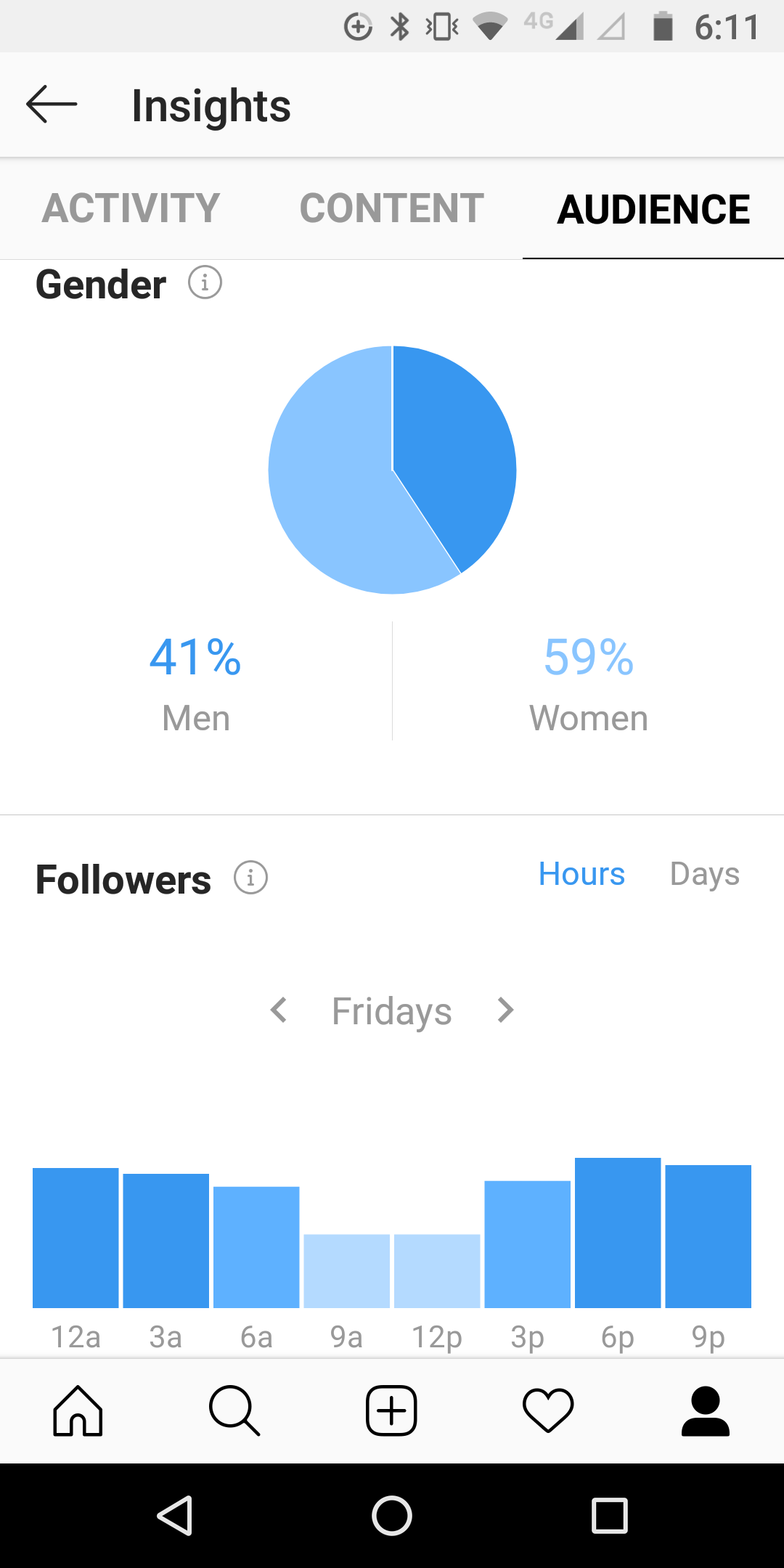Tap the profile icon to go to your profile. There’s no one time that’s best to post for all businesses. You’ll need to do some testing to determine what times seem to create the most engagement for your post (more on that later). From your business profile, tap Edit Profile, then Contact Options, then Add an action button. Take amazing photos To make Instagram work for your business, you’ve simply got to have great photos. How can you make the most of Instagram Stories? One way to do that is to engage with people and brands they already follow. It’s a great way to get your content in front of people who don’t already follow you. You might want to consider creating your own branded hashtag. You’ll want to track the results of individual posts, ads, and stories, as well as your Instagram business account as a whole.

More than 25 million companies worldwide are already using Instagram for business, and more than 200 million users visit at least one business profile every day.
As Facebook refocuses on connecting people with content from family and friends, Instagram has become “the new home for brands,” where engagement is high, followers are brand-loyal, and real business goals can be achieved.
Here’s everything you know about how to use Instagram for business—whether you’re just getting started or you simply need to refine your existing strategy.
Bonus: Download a free checklist that reveals the exact steps an adventure photographer used to grow from 0 to 110,000 followers on Instagram with no budget and no expensive gear.
Step 1: Get an Instagram business account
If you already have a personal Instagram account with brand-appropriate content and an established following, you might want to simply convert it to an Instagram business account. This gives you access to all the business features but makes the transition seamless for your existing followers.
You could also choose to create a brand-new Instagram business account. This is the right choice if you don’t have an existing personal account, or if your personal account does not accurately represent your business.
How to set up an Instagram business account from scratch
- Download the Instagram app for iOS, Android, or Windows.
- Open the app and tap Sign Up.
- Enter your email address and tap Next. If you want to connect your Instagram business account to your Facebook Business Page, make sure to use an admin email address to sign up, or tap Log in with Facebook.
- Choose your username and password and fill in your profile information. (We’ll dive into how to optimize your Instagram business profile information later in this post.)
- Tap Done.
- You now have a personal Instagram account that’s ready to convert to a business account. Continue by following the steps below.
How to convert a personal Instagram account to a business account
- Log into your existing personal Instagram account on the app.
- Tap the profile icon to go to your profile.
- Tap the three lines icon at the top right of the screen, then tap Settings.
- Tap Switch to Business Profile, then Continue.
- (Optional) If you want to connect your Instagram business account to your Facebook business page, follow the prompts to do so.
- Add contact information: Your Instagram for business account must include an email address, a phone number, or a physical address (or all of these).
- Tap Done.
Step 2: Create a winning Instagram strategy
Define your target audience
Before you can decide what kind of content to post in Instagram, you need to think about who’s going to see it.
The vast majority of Instagram users are under the age of 35, with a fairly close split between male and female users. The United States has the largest number of Instagram users, closely followed by India, Brazil, and Indonesia. That’s good information to get you started, but you need to go beyond these overall Instagram demographics to define a target audience unique to your brand.
Since defining your target market is one of the most important parts of your marketing strategy for any marketing tool, we’ve created a step-by-step guide that explains all the details. Here’s the short version:
- Determine who already buys from you.
- Check the analytics on your other social media channels to learn who follows you there.
- Create a clear value statement for your brand.
Once you understand who your audience is, think about what kind of content they want to see from you. What kind of content do they post on their own accounts? How do they interact with your competitors or similar brands?
Set goals and objectives
Knowing what you want to accomplish by using Instagram for business is the first stage in creating an effective Instagram strategy. Understanding your goals keeps you on track and allows you to focus all of your efforts on achieving real business objectives.
Effective goals follow the SMART framework. That means they are:
- Specific
- Measurable
- Attainable
- Relevant, and
- Timely
As you build your Instagram presence, it’s okay to have goals based on vanity metrics like likes, follows, and comments. But make sure you also set goals that relate to real business objectives. Which leads us to…
Focus on the right performance metrics
The exact metrics to measure and track will vary for each business. But, broadly, you should focus on metrics related to the social funnel.
That means your goals should align to one of the four stages in the customer journey:
- Awareness: Includes metrics like brand awareness, follower growth rate, and post reach.
- Engagement: Includes metrics like engagement rate (based on likes) and amplification rate (based on shares).
- Conversion: In addition to conversion rate, this includes metrics like click-through rate and bounce rate. If you’re using paid ads, conversion metrics also include cost per click and CPM.
- Customer: These metrics are based on actions customers take, like providing testimonials.
Commit to a regular posting schedule
Once you start building a following on Instagram, your fans will expect to see posts from you on a regular basis. You want to keep them aware of your brand and engaged with your content without overwhelming them to the point that they tune out—or worse, unfollow.
There’s no one time that’s best to post for all businesses. After analyzing 1,000 Hootsuite Instagram posts, the Hootsuite social marketing team found that the best time to post was 12 p.m. to 1 p.m. on weekdays, since followers were scrolling through Instagram on their lunch breaks.
That’s what works for Hootsuite. It’s not necessarily what will work for you. You’ll need to do some testing to determine what times seem to create the most engagement for your post (more on that later).
The key factor is to understand when your audience is online. Remember that they may not be in the same time zone as you are. Instagram Insights shows you exactly when your followers are online, broken down by day.

To access this information, go to your Instagram business profile, click the three bars icon in the top right, then click Insights. Click on the Audience tab and scroll down to see active times.
Once you determine your best time to post, create a content calendar to plan and schedule your Instagram content in advance.
Step 3: Optimize your profile
You entered some basic profile information when you first created your Instagram business account. Now it’s time to optimize your profile for the best results. Here’s a quick video that goes over the highlights:
Tweak your bio
Your Instagram bio is only 150 characters long, but it needs to do a lot of heavy lifting. It tells first-time visitors who you are, what your brand is all about, and why they should care.
How do you cram so much information into such a small space, while also conveying brand personality? We’ve got a full guide to creating an effective Instagram bio for business, but here are some quick tips:
- Use your brand voice: Convey your personality. Go casual, or professional, or a little bit cheeky, depending on what makes the sense for your business.
- Include hashtags: Instagram bio hashtags are clickable, and are a great way to show off user-generated content.
- Try emoji: These little symbols can help you convey a lot of information in just one character.
- Use spacing and line breaks: Line breaks make your bio easier to read online.
Optimize your profile pic
For most businesses, the best profile pic is some version of your logo. Use the same picture you use on other social profiles to help people instantly identify your brand.
Your profile photo displays as 110 x 110 pixels, but it’s stored at 320 x 320 pixels. That means it’s a good idea to upload a photo at least 320 pixels square to ensure you’re ready if Instagram changes how profile photos are displayed.
Your profile pic is cropped into a photo on the app, so make sure your logo is fully visible in this shape.
Make sure your profile is complete
Use all the components of your Instagram business account to their full advantage.
- Name and username: These are the only parts of your Instagram profile that are included in Instagram search, so use them wisely. Include your real brand name as well as any variations (like a common abbreviation). Using the same username (or handle) on all social networks makes it easier…

COMMENTS